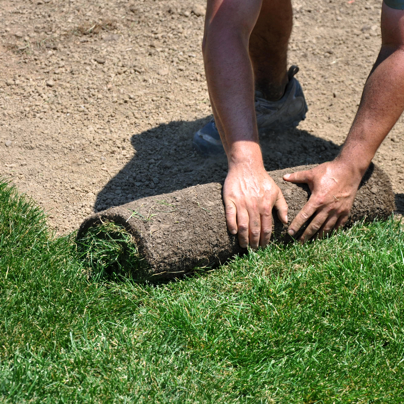 Whether you’re working on a lawn for your new home or redoing your old lawn, laying down sod is fastest way to get the job done. Check out our post on grading and landscaping to make sure you’re ready for this step!
Whether you’re working on a lawn for your new home or redoing your old lawn, laying down sod is fastest way to get the job done. Check out our post on grading and landscaping to make sure you’re ready for this step!
A beautiful green lawn requires a little work, but the result is certainly worth the effort. The best time to lay sod is during the early morning and late afternoon hours when it is not too hot. Definitely take your time to get it right and also to avoid straining your body. If you pace yourself, laying down sod is quite a good workout!
The first step in laying sod is to choose the right product for your lawn. Modernturf.com has some good suggestions on selecting quality sod.
-
- Look for sod with dense grass that has a uniform color.
- Check to see if the sod is moist near the roots.
- Look for grass with thick roots.
- Soil should be less than 1-in. deep, and the roots should intertwine.
- Use recently harvested sod.
Prepare the Soil
If you have an existing lawn, then you will need to remove the old sod first. You can do this with a rented sod cutter.
Make sure that the ground is moist but not waterlogged before planting. Watering for a few days before the sod arrives will usually get the job done. If it has been raining, check to see if the top four or five inches of the soil are wet. If the ground is muddy, let it drain until it has some integrity but is still moist.
Level the ground as much as possible and then add a coating of fertilizer. You can use natural fertilizer if you want to avoid potentially harmful chemicals. Apply the fertilizer to the top of the soil. No need to use a rototiller or to mix the fertilizer into the soil.
Once the sod arrives, make sure that it is moist before laying it on on the planting surface. Ideally, it should be moist but not saturated to the point that it is dripping water. If the soil is too moist, let it drain properly first. If it is too dry, water it a bit before laying it down. You want the bottom of the sod that will come into contact with the fertilizer to be moist.
Keeping the Sod Aligned
To ensure that your sod rows are as straight as possible, start off along the sidewalk or other straight-edged feature like a driveway or garden fence. If your lawn only has curving edges, you can set stakes across the lawn and attach strings to each stake to delineate straight rows.
Unroll the sod gently to avoid causing any damage to the grass or soil. Compress the sod tightly against the cement of sidewalks and driveways to avoid any gaps occurring later. The hot cement surface can cause the sod to shrink just a bit. If you laid out stakes, place the sod on along the side of the string to keep the rows straight.
Make sure each roll of sod is placed tightly against the adjoining roll. However, be careful not to damage the sod is it can tear and crumble rather easily.
Stagger the Roll Ends
Keep the sod edges tightly together without overlapping. Lay out the rolls in staggered pattern similar to laying brick. Again, you want to avoid gaps forming when the edges of the rolls dry out. However, make sure that you do not stretch the sod as this can create uneven patterns in the lawn.
Walking over the planting surface and dropping loose pieces of sod can cause the planting surface to become uneven as you work. Use a rake to keep the ground level as you lay the sod, so you don’t end up with a lumpy lawn.
If you come to a curvy edge, or if you need to cut holes for sprinklers or other lawn items, you can use a sharp knife to cut and shape the sod. No matter how hard you try, there will likely be at least a few gaps and seams in the sod when you’re finished laying out the rolls. Use potting soil, peat moss or similar organic matter to fill in these gaps. Do not use chunks of sod as they tend to dry out quickly and die.
Rolling the Sod
Now that you have laid out the sod, you will need to use a water-filled roller for leveling. The roller will also help you compress the sod against the planting surface so that the roots come into contact with fertilizer and topsoil. Fill the roller halfway with water and roll perpendicular to the length of the sod rows.
Once the sod is level, you will need to water the entire lawn thoroughly. The soil about six to eight inches deep beneath sod should be moist. Use a stiff wire to see how far down the moist soil goes. On hot, dry and windy days, you should moisten the ground as you lay the sod to prevent it from drying it out.
Now you’re done laying sod for your new lawn! Expect the work to take an entire weekend for a normal-sized yard.
Image courtesy of DepositPhotos.com, @ Stephen VanHorn
